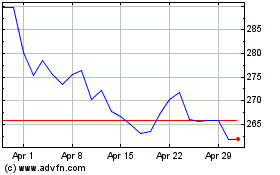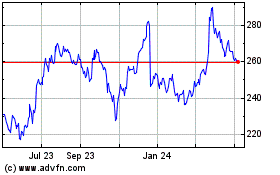FedEx Revenue Jumps on Holiday Surge -- Update
18 December 2020 - 10:55AM
Dow Jones News
By Paul Ziobro
FedEx Corp. isn't missing Amazon.com Inc. this holiday
season.
Shipping volumes at FedEx's Ground unit surged 29% in the latest
quarter, as consumers continued to buy everyday goods online, while
retailers urged them to do their holiday shopping earlier than
normal against the backdrop of the coronavirus pandemic.
The combination of factors boosted revenue and profits at the
delivery company for the three months ended Nov. 30, which included
Black Friday. FedEx has raised prices and handled a surge in
e-commerce packages this year, even after it publicly split ways in
2019 with Amazon, the biggest online retailer.
FedEx has found more than enough packages to fill its network
after parting ways with Amazon, helped by the overall growth of
e-commerce during the pandemic and courting of new customers.
Online sales rose 33% in the first nine months of 2020, FedEx said,
compared with just a 1% gain in overall retail sales, excluding
categories such as gas and food services.
FedEx's large Express unit posted a 10% jump in volume from a
year ago. It continues to benefit from tight capacity in the
air-cargo market, as a severe decline in passenger flights that
carried freight in their bellies has cut into supply. Air-cargo
companies such as FedEx have been flying fuller jets and charging
higher rates as a result.
The delivery company is in the midst of the busiest period for
shipping parcels ahead of the holidays, with around 100 million
packages dispatched daily across the industry, according to
ShipMatrix, a software provider that analyzes shipping data.
Industry data so far show that FedEx and United Parcel Service
Inc. have held up against the onslaught well, with on-time delivery
performance improving from last year.
However, part of it has come from stricter limits than usual on
how many items shippers can tender to the carriers daily. Both
companies have temporarily stopped accepting shipments from some
retailers, resulting in a backlog at some warehouses.
"All available capacity across the entire industry has been
severely constrained," FedEx chief marketing officer Brie Carere
said on Thursday's earnings call.
The carriers are also pushing rates up higher and adding new
fees to offset the cost of handling so many packages during the
pandemic. On Wednesday, FedEx said it would extend some peak-season
surcharges that were supposed to expire on Jan. 17 until further
notice because it expects costs and demand to remain elevated.
FedEx said the higher revenue was partially offset by higher
costs, including safety equipment to protect workers from Covid-19.
For its Ground network, that included hiring more workers than
usual before the holidays and opening several new facilities,
including one the weekend before Thanksgiving, to handle holiday
shipping volume.
"Peak preparation expenses were much higher and occurred much
earlier than in the past," Henry Maier, chief executive officer of
FedEx Ground, said.
For its fiscal second quarter ended Nov. 30, FedEx posted a
profit of $1.23 billion, or $4.55 a share, compared with $560
million, or $2.13, a year earlier. Revenue came in at $20.3
billion.
Analysts polled by FactSet on average expected FedEx to post
earnings of $4.01 a share on $19.4 billion in revenue.
FedEx continues to withhold its financial forecast for the
current fiscal year. Chief Financial Officer Michael Lenz said the
company expects earnings to grow in the second-half because of
"anticipated heightened demand for our services."
Write to Paul Ziobro at Paul.Ziobro@wsj.com
(END) Dow Jones Newswires
December 17, 2020 18:40 ET (23:40 GMT)
Copyright (c) 2020 Dow Jones & Company, Inc.
FedEx (NYSE:FDX)
Historical Stock Chart
From Mar 2024 to Apr 2024

FedEx (NYSE:FDX)
Historical Stock Chart
From Apr 2023 to Apr 2024
